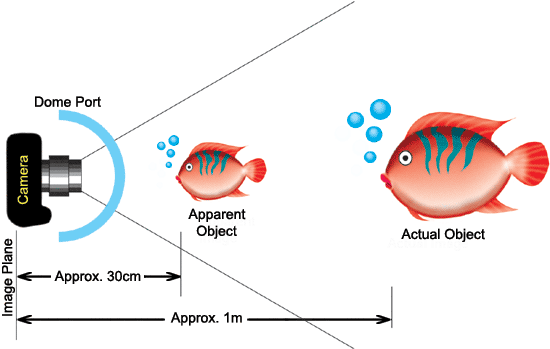 |
Ports and Lenses
Introduction
Underwater SLR housings usually have interchangeable lens ports. Some compact camera housings also have interchangeable ports. Potential users of such housings must select an appropriate lens and port combination in order to arrive at an optical system that fulfils requirements. In general, manufacturers offer a variety of flat ports, dome ports, extension rings, ports with additional controls, and mechanical linkages (gears etc.); and this article gives a brief summary of their properties and applications.

Sea & Sea SLR ports (NX-bayonet fitting)
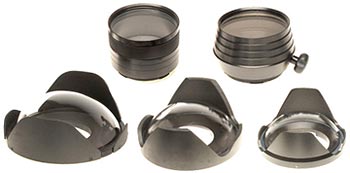 Aquatica ports |
 Subal ports |
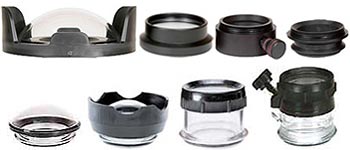
ikelite ports
Choice of lens
Water absorbs light, adds a colour cast and contains suspended particles. A general rule for underwater photography is therefore that pictures should be taken from as short a range as possible (within reason) unless special considerations dictate otherwise. This means that large objects and general scenery should be photographed using a wide-angle lens if possible, and small objects should be photographed using a close-focusing macro lens. Macro lenses of 50-60 mm focal length (35 mm equivalent) are best for photographing sedentary subjects because they place the least amount of water between the lens and the subject. For photographing fish and other animals which are likely to be disturbed by the proximity of the camera however, macro lenses of around 100 mm focal length are to be preferred.
Note that, although it is best to be close to the subject, this does not mean that there is no practical limit on the desirable angle of coverage for a wide-angle lens. The best choice for general underwater photography is to use a lens system with coverage in the range of about 75 to 100°. Beyond that lies a special realm of photography in which pronounced optical distortion occurs and effective flash illumination is difficult to achieve. This means that if you buy a super-wide lens system you should do so for a purpose, such as photographing whales or shipwrecks by natural light, or to use fisheye distortion for artistic effect.
Normal practice is to use flat ports for macro and other lenses of relatively long focal length, and to use a hemispherical dome port for wide-angle lenses. The optical reasons for those choices are discussed below. Note that ports, in general, do not have anti-reflection coatings. Consequently, under some lighting conditions, the camera may pick up a reflection of any writing or markings on the front of the lens. The solution is to go over any white or light-coloured markings with a black alcohol-based (permanent) felt-tip pen. Inking out the lens markings also improves performance when using ordinary filters and diopters above water. If you want to restore the lens to its original condition, you can remove the ink with cotton buds and alcohol (either industrial methylated spirit or isopropanol).
Flat (Macro) Ports
A flat port used underwater does not simply act as a window. Instead, the air-water boundary causes it to act as a lens. The effect of this compulsory extra lens element is to reduce the angle of coverage and increase the magnification provided by the main camera lens. The extra magnification is useful with macro lenses, which is why flat ports are also called macro ports. It also means however, that if (for example) you want the same angle of coverage as a 50mm lens, you must fit a 35mm lens. A table showing the reduction in coverage for a lens of a given focal length is given in the angle of coverage article.
Flat ports are not ideal for use with wide-angle lenses for several reasons: Firstly the port is likely to cause vignetting (cutting off the picture at the corners); secondly the port may introduce noticeable pincushion distortion (although this may be offset by barrel distortion of the lens); and thirdly the edge-sharpness of the picture will begin to deteriorate as the angle of coverage increases. The loss of sharpness is caused by chromatic aberration (colour fringing in off-centre detail). Assuming a 36 × 24 mm picture format, or 35 mm equivalent focal lengths, a general rule-of thumb is as follows: With 50 mm or longer lenses, chromatic aberration is negligible. A 35 mm lens will give acceptable results with a flat port, but is noticeably better with a dome port. A 28 mm lens with a flat port will give poor results. Chromatic aberration and pincushion distortion are however completely reversible using radial correction software; which means that, with a little extra effort in post-processing, sub-optimal lens-port combinations can be used without penalty except for the loss of coverage (provided that there is no vignetting).
 Aquatica housing with macro port |
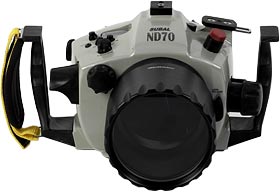 Subal housing with macro port |
Chromatic aberration of a 50mm lens and flat port
Shown below are 3 images scanned from a 35 mm (36 x 24 mm) transparency. The photograph was taken underwater using a Sigma 50 mm macro lens and a flat port, and was recorded on Kodachrome 25 film (the picture was taken a few years ago, but the laws of physics remain unchanged). The camera to subject distance was about 0.6 m. The first image gives an overview of the photograph, the second image is a detail from the exact centre of the picture, and the third image is a detail from the top left-hand corner.
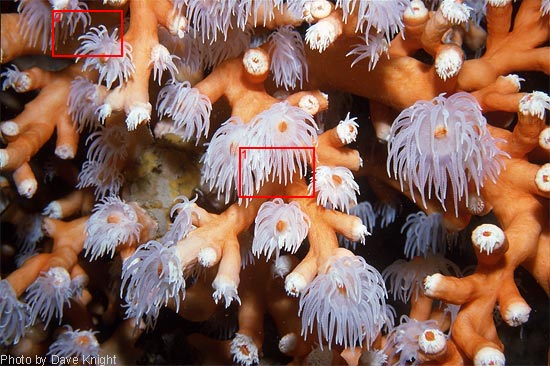
1) Complete photograph (red squares showing location of the pictures below)
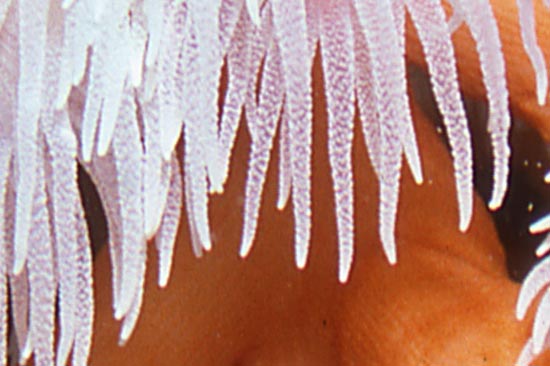
2) Centre detail scanned at 126 pixels / mm (3200ppi).
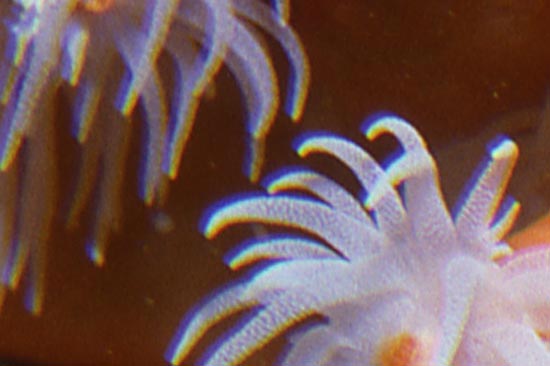
3) Top left corner detail scanned at 126 pixels / mm (3200ppi).
There is no colour fringing in the centre of the picture, but the corner image shows that detail in the blue colour channel is displaced outwards, and the red colour channel is displaced inwards (relative to the green channel), i.e., the magnification due to the lens-port combination is greater at the blue (short wavelength) end of the visible spectrum than it is at the red (long wavelength) end. This is classic chromatic aberration due to an underwater port. For pictures recorded using a 50 mm lens (35 mm format), the effect is noticeable to the trained eye in large prints, but is negligible for most purposes. As mentioned earlier, such aberration can be corrected in software (see the image radial correction article).
Macro Photography
Serious macro photography is done with a proper close-focusing macro lens rather than with the 'macro' setting of some general-purpose zoom lens. Macro lenses tend to change length somewhat radically as the focus setting is adjusted, and so it is important that the length of the port stem is chosen so that the lens cannot crash into the optical window. Manufacturers produce ports of varying stem length, or extension rings, to allow for this requirement.
One potential problem with macro lenses and long ports is that the lens will be a long way back in the port when set to focus at infinity. Hence it is not always possible to prevent vignetting when the lens is to be used for normal-perspective photography. This is a particular problem of 1:1 macro lenses of focal length in the 50-60 mm range.
Nowadays, many photographers are content to use auto-focus for macro photography and are perfectly happy with the results. AF is not necessarily optimal in this application however, firstly because focusing may be unreliable due to lack of light (an auxiliary focusing light is recommended) and secondly because the depth of field in macro photographs is often very limited. When photographing a three-dimensional object, it is best to focus on a point one third into into its depth, whereas an AF system will tend to focus on the nearest detail. Hence, you may prefer to use manual focusing, in which case it will be necessary to fit a gear or clamp around the focusing ring of the lens and connect it to a focus control. Since macro lenses are often physically long, the focus ring may be out of reach of the control actuators provided in the camera housing. For this eventuality, manufacturers produce ports with an auxiliary focus control.
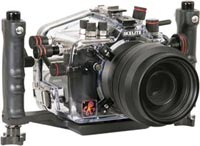 |
 |
 |
| ikelite housing with Macro port | #5502 Flat Port | #5506 Flat Port With Control |
Dome Ports
Dome ports were introduced in the 1960s, by the photographer Flip Schulke and others, and provided a solution to the problem of vignetting with fish-eye lenses. It soon became obvious however, that the dome port has another desirable property, which is that it corrects for the reduction in angle of coverage caused by the air-water boundary. A dome port is set-up for wide-angle photography by placing the entrance pupil of the lens at the centre of curvature of the dome (ie., the point at the middle if the dome were a complete sphere). In this case, light rays heading for the entrance pupil always strike the port surface at right-angles, no refraction occurs, and the angle of coverage of the main lens is conserved. This convenient situation comes at a price however, which is that the port acts as a strong de-magnifying lens.
The effect of the dome port is to make the subject appear much smaller and much closer than it really is, and the camera has to be able to focus on this 'virtual' image. This is not a problem with true wide-angle lenses, which have a very short minimum focusing distance, but with moderate wide-angle (28 & 35 mm) and standard lenses, it may be necessary to add a close-up lens to the front of the main lens, especially when using a dome of small-radius (see below). Needless to say, when using any underwater port, the distance markings on the lens are not to be believed.
Dome Radius or Diameter
Some manufacturers use a nomenclature which attributes a number of "inches" to a dome port. This measurement is not the diameter of the port assembly, but is the inside diameter of the complete sphere from which the dome is notionally cut. Hence an 8" dome port has a 4" radius of curvature, measured from the centre of the notional sphere to the inside surface of the dome. Similarly, a 6" dome port has a 3" radius of curvature. Since the angle of coverage of the camera lens is preserved when the entrance pupil (the place where the iris appears to be when looking into the lens) is placed at the centre of curvature, the radius of curvature is the preferred distance from the entrance pupil to the inside surface of the dome. When purchasing a dome port, it is necessary to obtain something close to the required distance by selecting a port with the nearest appropriate stem-length, or by choosing an extension ring of the appropriate length.
The proximity of the virtual image created by the dome is a function of the radius of curvature. Small radius domes place the virtual image closer to the camera than large radius domes. Hence a lens used behind a small radius dome is much more likely to require a supplementary close-up lens than a lens used with a large radius dome. The use of close-up lenses is best avoided if possible, but large radius domes have the disadvantage that they are delicate and vulnerable and contain a lot of air (i.e., additional ballast weight might be needed). Hence, instead of apportioning funds to the purchase of a large dome, it might be better to use a small dome and use the money saved to buy a lens with a small minimum focusing distance.
As a rough rule of thumb (based on the approximation that the refractive index of water is 4/3, and the dome is infinitely thin), a dome port of radius r will place the virtual image at a distance 4r from the centre of curvature. The centre of curvature is where the entrance pupil of the lens should be placed, but the lens distance markings and minimum focusing specification usually relate to the focal plane (i.e., the location of the film or sensor, sometimes marked with the symbol
 ), so
the lens needs to be able to focus at 4r + b, where b (the back focal
distance) is the distance from the entrance pupil to the focal plane.
The entrance pupil position may be obtainable from the lens
documentation, but can otherwise be estimated by noting where the iris
appears to be when looking into the lens. Thus, if we have
(say) a nominal 6" dome port with r=75 mm, then the virtual image in
water will be at about 300 mm in front of the lens entrance pupil.
If b is (say) 50 mm, then the lens will need to be able to
focus at <0.35 m if the system is to be able to bring light from
infinity to a focus. In practice, of course, we also want to
be able to focus on objects which are closer than infinity, and so
0.35 m minimum focusing distance is an upper limit (and the finite
thickness of the dome material actually brings the virtual image about
10 to 15 mm closer).
), so
the lens needs to be able to focus at 4r + b, where b (the back focal
distance) is the distance from the entrance pupil to the focal plane.
The entrance pupil position may be obtainable from the lens
documentation, but can otherwise be estimated by noting where the iris
appears to be when looking into the lens. Thus, if we have
(say) a nominal 6" dome port with r=75 mm, then the virtual image in
water will be at about 300 mm in front of the lens entrance pupil.
If b is (say) 50 mm, then the lens will need to be able to
focus at <0.35 m if the system is to be able to bring light from
infinity to a focus. In practice, of course, we also want to
be able to focus on objects which are closer than infinity, and so
0.35 m minimum focusing distance is an upper limit (and the finite
thickness of the dome material actually brings the virtual image about
10 to 15 mm closer).If a diopter lens is needed, note that the number of diopters is defined as the reciprocal of the focal length (of the diopter lens) in metres. Thus, if a dome port puts the virtual image at 4r from the centre of curvature, then a magnifying lens of 1/4r diopters placed at the centre of curvature (or thereabouts) will make the virtual image reappear at infinity. Thus a lens with poor minimum focusing distance used behind our example 6" (r=0.075 m) dome port will require a 1/(4 × 0.075) = 3.3 diopter lens screwed into its filter ring (a slight under-correction is acceptable; so 3 diopters will probably suffice, but more may be needed if the dome is thick or the diopter lens is a long way in front of the centre of curvature).
Virtual image position and infinity restoration
(Approximation based on infinitely thin dome and refractive index of water = 4/3. Actual virtual image for typical port will be 10 to 15 mm closer to the camera.)
| Dome type | Optical
radius / mm |
Centre
to virtual image / m |
Infinity
restoration / Diopters |
| 6" | 75 | 0.3 | 3.3 |
| 8" | 100 | 0.4 | 2.5 |
| 9" | 112.5 | 0.45 | 2.2 |
For an accurate formula for the virtual image position, and a calculation spreadsheet, see the Dome port theory article.
Optical quality
Assuming that the main camera lens is perfect (and therefore also mythical), a small radius dome port introduces more chromatic aberration (colour fringing in off-centre detail) than a large radius dome. An improvement in optical quality is not guaranteed by changing to a larger dome however, because the aberration introduced by the small dome may just as easily cancel some of the aberration of the main lens as increase it. Assuming that a close-up lens is not required, the lens data needed to determine which radius of port will give the sharpest pictures with a given lens is difficult to obtain, so it is probably best to choose the port radius on practicalities (size, buoyancy, vulnerability) rather than optical subtleties such as this.
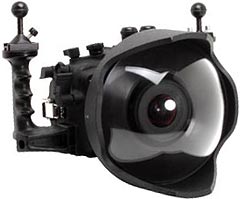 Aquatica housing with 8" dome port |
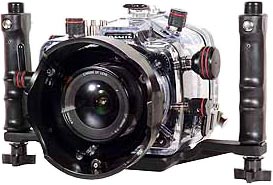 Ikelite housing with 6" dome port #5503 |
 Ikelite 6" dome port #5503 |
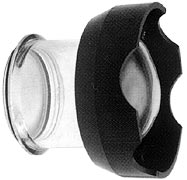 Ikelite extended 6" dome port #5503.80 |
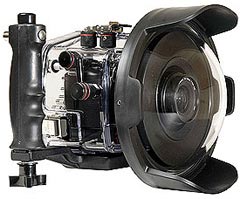 Ikelite housing with 8" dome port #5510.82 |
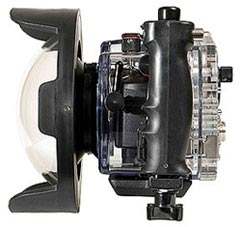 |
Half-In Half-Out
If a camera housing with a dome port is used above water, the apparent position of the object will be very little affected by the presence of the dome. This presents a problem when taking half-in half-out photographs, because the camera must be able to focus both on the normal object above water and on a nearby virtual image of the object below water. The large dome has a clear advantage in this situation, because it ensures that the virtual image is as far away as possible. A large depth of field is still required however, so half-in half-out photographs are best attempted using a wide angle lens operated at a small aperture.
| Note that, because a flat port does not preserve the angle of coverage of the camera lens, a half-in half-out photograph taken using a macro port will show the underwater part of the image magnified relative to the above-water part. Shown right is a half-in half-out picture taken using a 50 mm lens behind a flat port. The effect obtained is generally considered to be undesirable, which is why a dome port is normally used. | 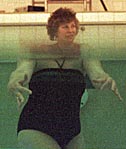 |
Use of Zoom Lenses
Wide-angle zoom lenses of limited zoom range can be used behind a dome port in much the same way as a fixed focal-length wide angle lens. In such cases the zoom ring is fitted with a gear and connected to a control provided on the camera housing, and the increase in versatility in comparison to the use of a fixed focal-length lens is definitely worthwhile.
For longer focal length "standard" zoom lenses (e.g., 28-70 mm), the optical situation is usually not so good. Some people like to use these lenses because they have a built-in 'macro' facility and seem to offer everything in one package. The problem however is that most of these lenses change length sustantially as the zoom control is rotated, and are physically shortest at the wide-angle setting. The port length has to be chosen to allow for the lens at its maximum extension, but then the front of the lens will be a long way from the port at the wide-angle setting and vignetting will result. The solution to the vignetting problem is to use a dome port, but then the optimum magnification will not be obtained in macro mode. Wide-range zooms also tend to have poor minimum focusing distances, which means that macro photographs have to be taken from some distance (resulting in foggy pictures), and the lens may not be able to focus on the virtual image produced by the dome underwater. It then becomes necessary to add a close-up lens to the front of the zoom lens, which reduces the lens resolution slightly and prevents the system from focusing above water.
Some zoom lens designs are physically longest when set for widest-angle. These lenses can often be used to good effect with a flat port (bearing in mind chromatic aberration at the wide-angle end), but care is needed in selection of the correct port length.
Most housing manufacturers provide only a rotary coupling to the lens zoom barrel. Hence push-pull type zoom lenses cannot be used (except perhaps by pre-setting the focal length before closing the housing).
 DWK
DWK© Dave Knight & Steve Knight. 2006 - 2011, 2012. Updated Feb. 2018.
